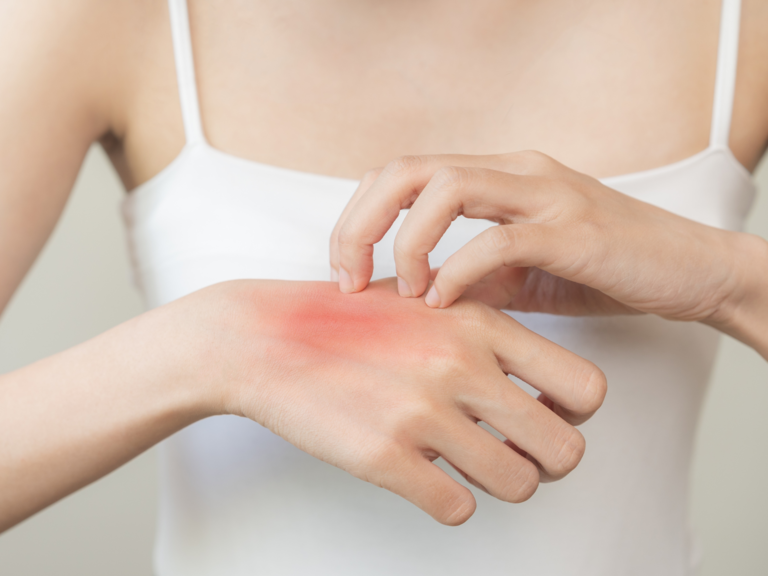Could You Be Allergic to Your Engagement Ring?

Discovering that you may be allergic to your engagement ring can be extremely disappointing. Maybe you've developed splotchy, red skin underneath the band or overall discomfort whenever you slide it on. Either way, the prospect of having to ditch such a significant piece of jewelry or deal with an itchy finger for the rest of your life is certainly unappealing.
Thankfully, the condition is both common and curable, so you won't have to say goodbye to your beloved ring. We've gathered expert tips on how to narrow down the culprit behind your rash, which symptoms to look out for, and how to treat them.
In this article:
- What Allergens Are In Engagement Rings?
- Signs You May be Allergic to Your Engagement Ring
- What to Do if You're Allergic to Your Engagement Ring
What Allergens Are In Engagement Rings?
Certain metal allergens, which are commonly found in engagement rings, are usually the catalyst behind contact dermatitis (also known as 'wedding ring rash'), an itchy rash caused by direct contact with a material or substance. "The most frequently reported allergic reactions are due to nickel and cobalt" explains Nidhi Dangayach, Jewelry Expert and Founder of Verlas. Both materials are most commonly present in yellow and white gold which "are an alloy/blend of various elements, including gold, silver, nickel, cobalt, copper, and others, combined in varying proportions" says Dangayach.
"Although there may be small traces of these allergens in your jewelry, they can still irritate," says Sarah Ortega, Owner and President, Sarah O Jewelry. She notes that it's possible to develop a nickel allergy later in life, especially after prolonged exposure to the metal. Unfortunately, there is no cure for nickel intolerance and the allergy lasts for the duration of one's lifetime.
Signs You May be Allergic to Your Engagement Ring
If you are reacting to your engagement ring, you may experience various symptoms related to wedding ring rash, that may range from mild to severe. Here are some signs that you could be allergic to your ring:
Irritation
When the flares up, your skin will likely show a visible reaction over time. "Typically, you will notice blistering, itching, swelling, or redness after wearing the piece that will form in the shape of the ring" Ortega mentions. Also, when these symptoms build up, they can "leave a black or green mark on the skin" she explains.
Flaky Skin
You may also notice that your skin texture changes or develops leathery patches, in reaction to your ring. This can look like "bumps, dryness, scaly patches, cracked or peeling skin" details Dangayach. These changes derive from "alloy allergies originating from jewelry" and can worsen if the reaction persists over time.
Pain
A painful sensation is also associated with contact dermatitis. It can feel like a burning, stinging, or throbbing. These feelings of discomfort may accompany other symptoms, making it extremely uncomfortable to wear the ring.
What to Do if You're Allergic to Your Engagement Ring
The good news is you don't have to give up wearing your much-loved piece of jewelry. Our experts provided a list of immediate steps you can take to nix any symptoms or how to find a safe, new ring if need be.
Get Tested
Consult a dermatologist so "they can perform patch testing to confirm the specific allergen that is making you react" instructs Dangayach. With this insight, your doctor can advise on which metals to avoid and which are safe. You should also ask them for guidance on treating any lingering symptoms and avoiding future allergic reactions.
Create a Barrier
Coating the inner surface of the ring with creams to create a protective layer may also be effective. You can use a hypoallergenic hand lotion or even a topical Cortisone. If those don't work, seek guidance from a dermatologist. Another option is plating the ring with a hypoallergenic metal coating, like platinum or rhodium, a durable metal in the platinum family.
Keep It Clean
If you don't have a metal allergy, washing your ring routinely with a jewelry cleaning solution at home or by a professional jeweler may prevent major symptoms. It will clear up any bacteria buildup, dirt, or residue from products like lotion, fragrance, or soap. Over time, these impurities can accumulate on the metal's surface and cause dermatitis. Also, always remove your rings while washing your hands and dry them thoroughly afterward to avoid trapping moisture underneath the ring's surface.
Make a Change
If none of these methods work, it may be necessary to switch to an entirely new wedding band. Some metal options are platinum or palladium, which are less likely to cause skin irritation. Or look into less popular, choices like titanium, cobalt chrome, ceramic, and zirconium, which are all hypoallergenic as well.
Analyze Your Metal
Moving forward, if you're considering purchasing a new band or plating the ring, always ask about the composition of the metal. Remember, rings that are plated with a thin layer of non-hypoallergenic metals may cause reactions if the plating wears off over time. This is especially important for white gold, which can have a minimal amount of nickel.























